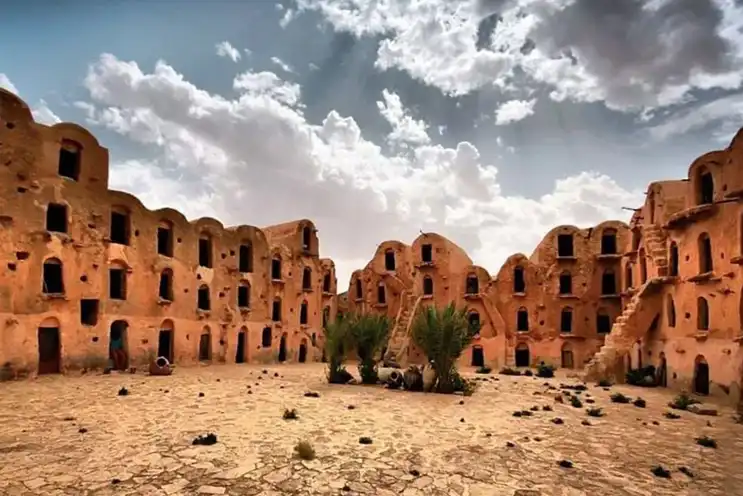Ksar Ouled Soltane lies within the heart of southern Tunisia’s Tataouine region. It represents a majestic testament to the cultural heritage of the area. This awe-inspiring ksar, a complex of historical granaries, showcases the ingenuity of its Berber inhabitants and their profound historical significance..
Unveiling Ksar Ouled Soltane: Glimpsing Tunisia’s Past
Dating back to the 15th century, the ksar boasts a multi-story design with granaries elegantly stacked in a tiered arrangement. Its exterior features distinctive crenelated walls and watchtowers that blend beauty with fortification. Upon stepping inside, a sprawling central courtyard, adorned with intricate patterns and arabesque motifs reflecting the remarkable craftsmanship of the time, welcomes visitors. Embracing a dual role, this locale once served as both a vital grain storage facility and a refuge from the unforgiving desert environment. Over time, it has evolved into a sought-after global tourist destination, extending an invitation to visitors to immerse themselves in the captivating narratives of Berber culture and their enduring connection to the land. Embarking on a journey through time and heritage entails exploring Ksar Ouled Soltane.
A Fortified Legacy: Ksar Ouled Soltane’s Story
Positioned about 20 km south of Tataouine, Tunisia, Ksar Ouled Soltane stands as an exceptionally well-preserved fortified granary, crafted by Berbers in the 15th century. Crafted from adobe (natural earth), the ksar encompasses two courtyards, each featuring vaulted attic spaces known as ghorfas, which served to store food.
In ancient times, fortification of granaries was common practice to prevent raids on essential food supplies within villages. Much like other North African Berber granaries, Ksar Ouled Soltane rests atop a hill, effectively shielding it from potential threats.
The ksar was originally built in the 15th century, initially housing numerous ghorfas for grain storage. Later, during the 19th century, expansion occurred, resulting in a second courtyard and a total of 400 ghorfas.
These courtyards are connected through a passageway constructed of palm wood. Originating in the 15th century, the ksar initially housed a multitude of ghorfas designated for grain storage. The 19th century witnessed an expansion, giving rise to a second courtyard and the addition of 400 ghorfas, a testament to its growth and historical significance..

Comment (0)